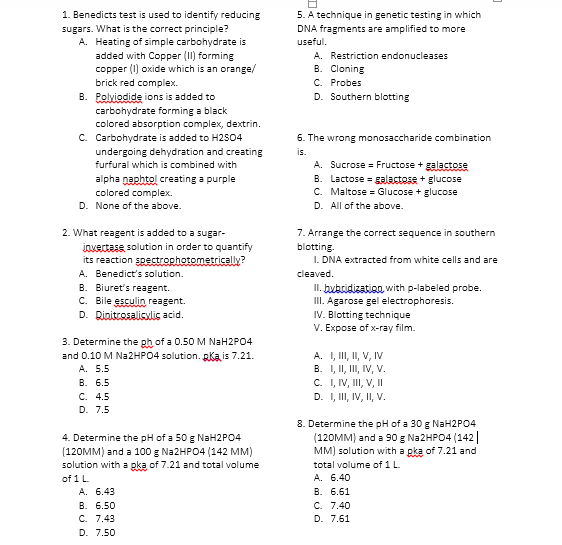1. Benedicts test is used to identify reducing sugars. What is the correct principle? A. Heating of simple carbohydrate is added with Copper (I1) forming copper (1) oxide which is an orange/ brick red complex. B. Polviodide ions is added to carbohydrate forming a black colored absorption complex, dextrin. C. Carbohydrate is added to H2504 undergoing dehydration and creating furfural which is combined with alpha paphtol creating a purple colored complex. D. None of the above.
1. Benedicts test is used to identify reducing sugars. What is the correct principle? A. Heating of simple carbohydrate is added with Copper (I1) forming copper (1) oxide which is an orange/ brick red complex. B. Polviodide ions is added to carbohydrate forming a black colored absorption complex, dextrin. C. Carbohydrate is added to H2504 undergoing dehydration and creating furfural which is combined with alpha paphtol creating a purple colored complex. D. None of the above.
Biology: The Dynamic Science (MindTap Course List)
4th Edition
ISBN:9781305389892
Author:Peter J. Russell, Paul E. Hertz, Beverly McMillan
Publisher:Peter J. Russell, Paul E. Hertz, Beverly McMillan
Chapter19: Genomes And Proteomes
Section: Chapter Questions
Problem 1TYK
Related questions
Question

Transcribed Image Text:1. Benedicts test is used to identify reducing
sugars. What is the correct principle?
A. Heating of simple carbohydrate is
5. A technique in genetic testing in which
DNA fragments are amplified to more
useful.
added with Copper (II) forming
copper (1) oxide which is an orange/
brick red complex.
A. Restriction endonucleases
B. Cloning
C. Probes
D. Southern blotting
B. Polviodide ions is added to
carbohydrate forming a black
colored absorption complex, dextrin.
C. Carbohydrate is added to H2504
6. The wrong monosaccharide combination
undergoing dehydration and creating
is.
A. Sucrose = Fructose + galactose
B. Lactose = galactese + glucose
C. Maltose = Glucose + glucose
D. All of the above.
furfural which is combined with
alpha naphtol creating a purple
colored complex.
D. None of the above.
7. Arrange the correct sequence in southern
2. What reagent is added to a sugar-
jovertass solution in order to quantify
its reaction seectrophotometrically?
A. Benedict's solution.
B. Biuret's reagent.
C. Bile esculin reagent.
D. Rinitrosalicyxlis acid.
blotting.
I. DNA extracted from white cells and are
cleaved.
II. bubridization with p-labeled probe.
II. Agarose gel electrophoresis.
IV. Blotting technique
V. Expose of x-ray film.
3. Determine the ph of a 0.50 M NAH2PO4
and 0.10 M N22HPO4 solution. Rka is 7.21.
A. I, II, II, V, IV
B. I, II, III, IV, V.
C. I, IV, II, V, II
D. I, II, IV, II, V.
А. 5.5
В. 6.5
С. 4.5
D. 7.5
8. Determine the pH of a 30 g NaH2PO4
(120MM) and a 90 g N22HPO4 (142||
MM) solution with a gka of 7.21 and
total volume of 1L.
A. 6.40
В. 6.61
C. 7.40
D. 7.61
4. Determine the pH of a 50 g NaH2PO4
(120MM) and a 100 g N22HPO4 (142 MM)
solution with a pka of 7.21 and total volume
of 1 L.
A. 6.43
В. 6.50
C. 7.43
D. 7.50
Expert Solution
This question has been solved!
Explore an expertly crafted, step-by-step solution for a thorough understanding of key concepts.
Step by step
Solved in 2 steps

Recommended textbooks for you

Biology: The Dynamic Science (MindTap Course List)
Biology
ISBN:
9781305389892
Author:
Peter J. Russell, Paul E. Hertz, Beverly McMillan
Publisher:
Cengage Learning

Biology: The Unity and Diversity of Life (MindTap…
Biology
ISBN:
9781305073951
Author:
Cecie Starr, Ralph Taggart, Christine Evers, Lisa Starr
Publisher:
Cengage Learning


Biology: The Dynamic Science (MindTap Course List)
Biology
ISBN:
9781305389892
Author:
Peter J. Russell, Paul E. Hertz, Beverly McMillan
Publisher:
Cengage Learning

Biology: The Unity and Diversity of Life (MindTap…
Biology
ISBN:
9781305073951
Author:
Cecie Starr, Ralph Taggart, Christine Evers, Lisa Starr
Publisher:
Cengage Learning
